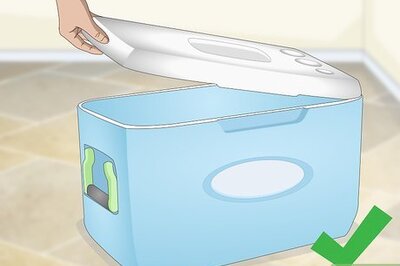
views
What is an EVAP leak?
An EVAP leak occurs when excess gas isn’t burned away. There is a lot of distance between your gas cap and the engine, and fuel—like all liquids—condensates and evaporates. So where does the extra fuel runoff go? Enter your EVAP system. The EVAP system contains a charcoal canister (that collects fuel vapors) and a purge valve/solenoid (that releases the vapors into the engine). If you have an EVAP leak, it means those fuel vapors are leaking out somewhere outside of the vehicle. Technically, your fuel tank, gas cap, and fuel lines are a part of the EVAP system in the sense that they’re all connected to the canister and purge valve. Most people are referring to the charcoal canister and purge valve/solenoid when they refer to the EVAP system, though.
Can you drive with an EVAP leak?
No, an EVAP leak is dangerous and bad for the environment. Fuel is combustible, so any gasoline leak has the potential to create a car fire. While the odds this happens are low (since the gas is outside of the vehicle), they aren’t nonexistent so you shouldn’t drive on these grounds alone. However, EVAP leaks also release noxious fumes into the environment, so it’s really not responsible to continue driving.
Symptoms of an EVAP Leak
You smell gas. The EVAP system is supposed to keep gas fumes and condensation out of the environment, so if there’s a leak the most obvious sign will be gas odors. If you smell gasoline outside of your car regardless of when or where you fill up, it could point to an EVAP leak. If the leak is especially bad, you may even notice you’re going through so much gas that you’re filling up way more often than you normally do. You may smell gas inside of your car if the leak is anywhere near the cab filter. If the charcoal canister is the leaky component, the gas odor may be a little more subtle. The charcoal is designed to absorb gas fumes, so any leaks will likely smell diluted or minor.
You find gas puddles under your car. The gas may mix with water from the condensation in your AC system, exhaust, or windshield wiper reservoir, so it may not look or smell like pure gas. Still, any kind of gas puddle under your engine could point toward an EVAP system leak. These puddles are unlikely to be very big. The EVAP system only collects runoff, evaporation, and condensation, so you’re less likely to see huge pools and more likely to see small puddles.
Your check engine light is on. The EVAP system is a core component of the engine’s emissions system, so if there’s an EVAP leak your check engine light should come on. If you don’t see any indicators on your dashboard, it’s unlikely you’ve got an EVAP leak.
Your car has a rougher idle than it used to. You know your vehicle better than anyone else, so turn the ignition on and just let it sit in park (or idle down the alley). Is your car vibrating or shaking more than it normally would? If so, it could point to an EVAP leak. An EVAP leak will cause idling to feel funny as the gas runoff isn’t being collected correctly. This may not occur if the leak isn’t interfering with any other engine components.
Your car’s performance is poor. If the leak is bad enough, your engine may not function properly. Fuel may not flow evenly through your fuel lines or the leak may interfere with another sensor or component in your engine bay. This isn’t a universal sign. You could have an EVAP leak and notice nothing wrong at all with your car’s performance.
How to Confirm an EVAP Leak
Make sure your gas cap is closed and working. In fringe cases, a damaged gas cap can cause an EVAP leak. Open and close your gas cap to confirm that it’s fully closed and the seal is tight. If the cap looks damaged or it’s not closing correctly, that’s probably the source of your issue. Replace the gas cap and reset the check engine light to see if that solves your problem.
Run an OBD-2 scan to see if you get a leak code back. If you have an OBD-2 scanner, plug it into the port underneath your steering wheel (or in your glovebox). Press the “scan” button and inspect the results. The code will tell you if there’s an EVAP leak or something else going on. The code for an EVAP leak is P0455, although there may be another code depending on the scope or location of the leak.
See a mechanic to have them run a smoke or dye test. A smoke or dye test is the industry standard for finding leaks in a car. Basically, the mechanic will pump harmless smoke or liquid dye into the fuel tank. Then, they’ll follow the entire length of your fuel lines until they find the dye or smoke where it shouldn’t be. The mechanic may run a pressure and vacuum test, first. This involves pressurizing the fuel system to see if the pressure stays stable. If it doesn’t, it confirms that there’s a leak somewhere. You can run a dye test yourself, but if you don’t know how to fully disassemble or assemble a car, you may not have the ability to find the precise source of the leak.
How to Fix an EVAP Leak
Ask your mechanic to patch or replace the leak. Replacing a charcoal canister, purge valve, or solenoid is not a DIY task. Fuel is also noxious and flammable, so unless you have experience working on your gas lines, leave this one to your mechanic. What’s it going to cost? Expect to spend $200-600 depending on the location of the leak and whether anything actually needs to be replaced or not. Patching a leaky fuel line will run cheaper than replacing a solenoid or canister.

















Comments
0 comment